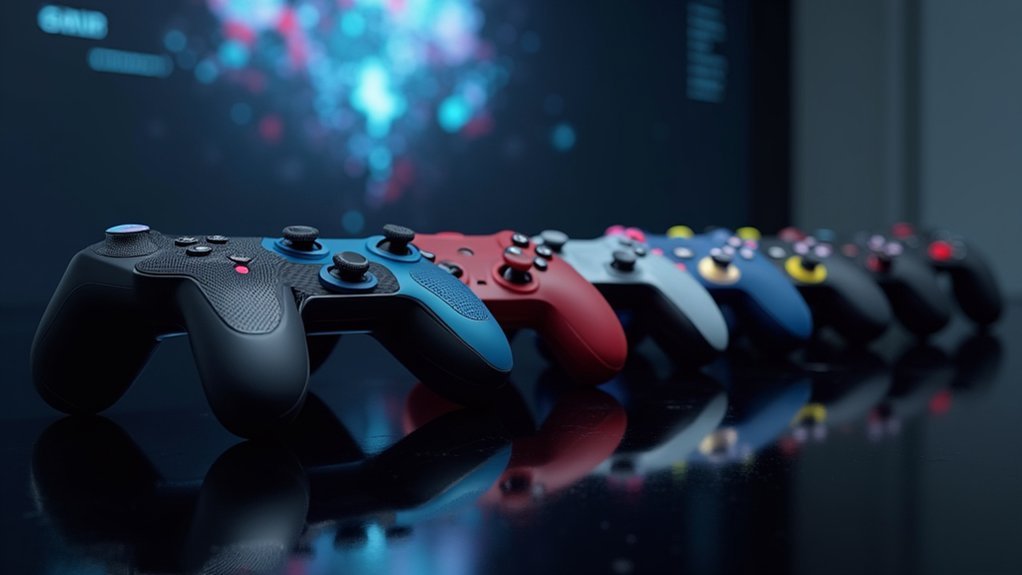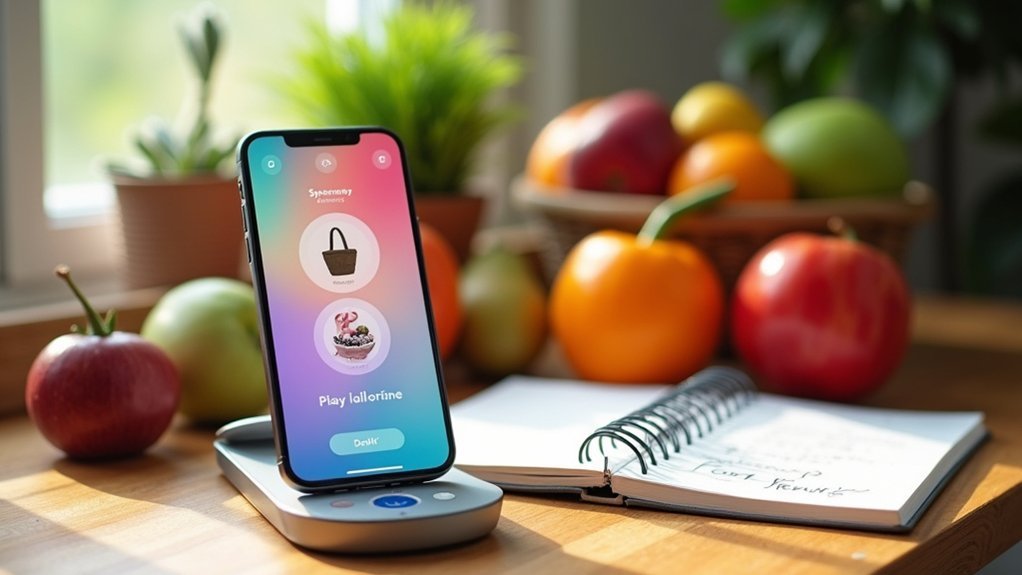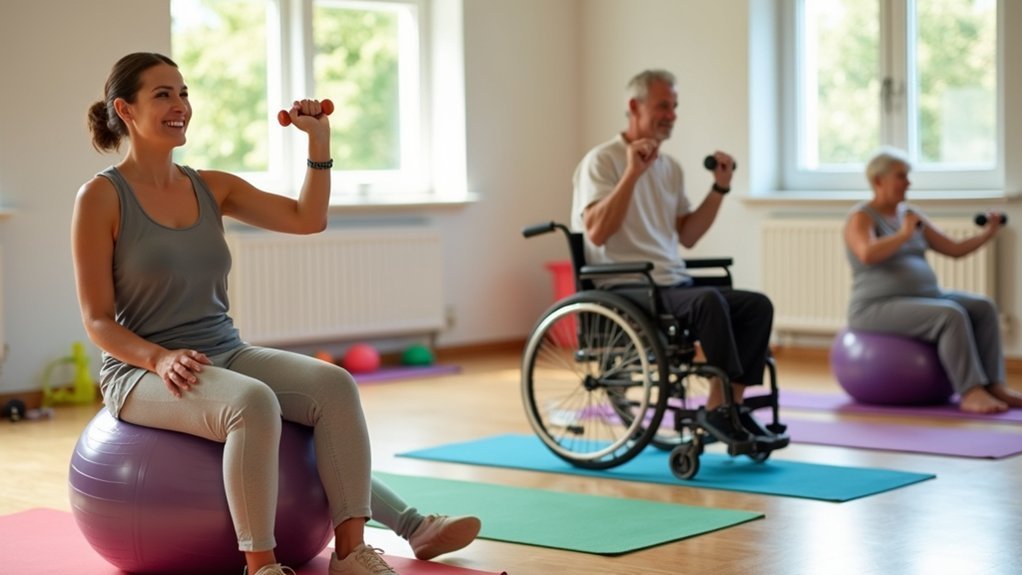You’ll design perfect VR controls by prioritizing natural hand movements over complex button combinations, keeping your arms below shoulder level to prevent fatigue. Focus on sub-20 millisecond response times for seamless interactions, implement clear visual and haptic feedback, and guarantee your gesture recognition accommodates various hand poses. Include customizable sensitivity settings and button remapping for different users’ needs. Test extensively with diverse user groups to identify comfort issues and refine your control schemes for peak performance and accessibility in virtual environments.
Understanding VR Controller Fundamentals and Input Methods

Motion tracking forms the backbone of modern VR controllers, transforming your natural hand movements into precise digital interactions within virtual worlds.
These sophisticated devices employ various input methods to capture your gestures, from simple button presses to complex spatial movements that translate seamlessly into the virtual environment.
When selecting VR controllers, you’ll encounter handheld devices featuring buttons, triggers, and touchpads that offer multiple engagement options.
These input methods provide versatile ways to manipulate virtual objects and navigate menus intuitively.
Ergonomic factors play a significant role in controller design, ensuring comfortable extended use while promoting natural interactions.
The shape, weight distribution, and button placement directly impact your comfort during lengthy gaming sessions, making ergonomics essential for ideal VR experiences.
Designing Natural Hand Gestures for Immersive Interactions
You’ll need to build gesture recognition systems that interpret hand movements as naturally as pointing at objects or grasping items in the real world.
Your VR interface should prioritize virtual hand interactions over controller buttons, letting users engage through familiar motions like pinching, grabbing, and waving.
Keep interactions at comfortable arm positions below shoulder level to prevent fatigue, since users will spend extended periods moving their hands through virtual spaces.
Intuitive Gesture Recognition Systems
| Gesture Type | Movement Pattern | Fatigue Level | Visual Feedback | User Comfort |
|---|---|---|---|---|
| Semantic | Natural hand motion | Low | Object highlighting | High |
| Responsive | Environmental interaction | Medium | Hand pose adjustment | Medium |
| Button-free | Direct manipulation | Low | Object enlargement | High |
| Elevated | Raised arm position | High | Minimal feedback | Low |
| Ground-level | Elbow-supported | Minimal | Clear indicators | Maximum |
Effective visual feedback enhances your understanding while continuous user testing refines system responsiveness. You’ll experience reduced fatigue when gestures maintain elbow contact with your body.
Reducing Hand Interaction Fatigue
Provide thorough feedback through visual, audio, and haptic responses so users don’t need excessive movement to confirm actions.
Conduct regular user testing with VR newcomers to identify comfort issues and accommodate different physical capabilities in your gesture designs.
Implementing Eye Tracking Controls for Hands-Free Navigation
You’ll need to start with proper eye tracking calibration to guarantee accurate gaze detection before users can navigate your VR environment effectively.
Once calibrated, you can implement gaze-based menu selection by allowing users to look directly at interface elements to highlight and activate them.
This approach eliminates the need for hand controllers and creates a more intuitive interaction method that responds immediately to where users naturally focus their attention.
Eye Tracking Calibration
Calibration transforms your gaze into a precise navigation tool within virtual environments.
You’ll need to focus on specific calibration points to align your eye movements with the VR system’s tracking capabilities. This process guarantees your natural gaze translates accurately into intentional interactions within the virtual space.
The calibration process typically involves these steps:
- Focus on designated calibration points displayed throughout your field of view
- Maintain steady gaze for several seconds at each point
- Complete multiple rounds to verify tracking accuracy
- Test responsiveness by looking at various interface elements
Proper eye tracking calibration enhances your interaction design experience while improving accessibility for users with mobility limitations.
Modern systems target sub-20 millisecond response times, creating seamless hands-free navigation that feels natural and responsive.
Gaze-Based Menu Selection
Once your eye tracking system is properly calibrated, gaze-based menu selection transforms how you navigate virtual interfaces by eliminating the need for physical controllers. You’ll experience reduced cognitive load and fatigue during extended sessions since you don’t need to physically reach for anything.
Your gaze-based menu selection system works effectively when UI elements are positioned within the goldilocks zone of 2-10 meters from eye level. The 100 Hz sampling rate guarantees smooth, responsive interactions that feel natural and immediate.
| Distance | Interaction Quality | Recommended Use |
|---|---|---|
| 0-2m | Poor visibility | Avoid |
| 2-5m | Excellent | Primary menus |
| 5-10m | Good | Secondary options |
| 10m+ | Reduced accuracy | Background elements |
Implement visual feedback like highlighting and enlarging focused items to enhance your VR experience and boost navigation confidence.
Creating Voice Command Systems for Accessible VR Experiences
Voice command systems represent one of the most transformative approaches to making VR experiences truly accessible for users with diverse abilities. By implementing natural language processing, you’ll enable conversational interactions that reduce learning curves and enhance intuitive user interaction.
These systems eliminate barriers for users with mobility impairments while reducing cognitive load for everyone.
Here’s how voice command systems enhance accessibility:
- Hands-free navigation – Users can control virtual environments without physical controllers
- Real-time feedback – Voice recognition provides immediate confirmation of actions
- Multitasking capability – Reduced cognitive load allows simultaneous task performance
- Conversational interface – Natural language commands feel more intuitive than complex menu systems
Continuous AI advancements improve accuracy and responsiveness, making voice command systems increasingly viable for creating inclusive VR experiences.
Optimizing Hand Tracking Technology for Precise Movements
While voice commands provide powerful accessibility features, hand tracking technology offers an equally compelling approach to controller-free VR interactions through natural gesture-based control.
You’ll need to optimize your system’s sensors and cameras to accurately capture hand movements while minimizing environmental interference from poor lighting or busy backgrounds.
Keep latency under 20 milliseconds to maintain real-time feedback and prevent motion sickness.
Implement machine learning algorithms that adapt to your users’ unique hand shapes and behaviors, improving tracking accuracy over time.
Focus on robust gesture recognition capabilities that distinguish between specific hand poses like grabbing, pointing, and swiping.
These optimizations guarantee your users experience fluid, intuitive interactions that feel natural and responsive within your virtual environment.
Building Customizable Button Mapping and Control Schemes
You’ll want to create user input mapping systems that let players assign functions to their preferred buttons and gestures.
Your adaptive control systems should automatically adjust to different hardware configurations and user abilities, ensuring seamless changes between various VR devices.
Don’t forget to implement thorough accessibility configuration options that accommodate users with different physical capabilities and comfort levels.
User Input Mapping
Since every VR user brings different physical abilities, preferences, and gaming backgrounds to the virtual environment, creating customizable button mapping becomes essential for delivering truly accessible experiences.
Your user input mapping strategy should focus on building intuitive gestures that feel natural and predictable.
A flexible control scheme requires these key elements:
- Prioritize common actions – Make grabbing, pointing, and movement easily accessible
- Implement adjustable sensitivity – Let users fine-tune interaction responsiveness to their comfort levels
- Conduct regular user testing – Identify potential confusion between gestures and accidental inputs
- Provide clear feedback – Use visual and audio cues to reinforce connections between physical movements and virtual actions
This approach guarantees your control system adapts to users rather than forcing them to adapt.
Adaptive Control Systems
Building on these foundational mapping principles, adaptive control systems take personalization several steps further by empowering users to completely reorganize their VR interface according to their unique needs and preferences.
You’ll discover these systems accommodate diverse user types, from beginners requiring simplified layouts to users with accessibility requirements needing specialized configurations.
When implementing adaptive control systems, you’ll find that customizable schemes greatly enhance comfort while reducing learning curves. This enhanced personalization directly boosts immersion levels throughout your VR experience.
Software tools and APIs streamline development, allowing you to easily modify control layouts based on real-world usage patterns.
Remember that continuous usability testing remains essential for refinement. You’ll need consistent feedback collection to guarantee your adaptive systems align with user needs and maximize interaction effectiveness across all user demographics.
Accessibility Configuration Options
While adaptive systems provide the framework for personalization, accessibility configuration options form the practical core that transforms VR interfaces into truly inclusive experiences.
You’ll need extensive settings that accommodate diverse physical abilities and preferences through customizable interactions.
Essential accessibility configuration features include:
- Button remapping controls – Let users reassign functions to comfortable positions based on their motor capabilities.
- Adjustable input sensitivity – Provide granular control over device responsiveness to prevent unintended actions.
- Multiple control schemes – Offer preset configurations for different accessibility needs and interaction styles.
- Visual and auditory feedback options – Enable users to customize confirmation signals for better interaction understanding.
Regular user testing with diverse groups reveals unique accessibility requirements you might overlook.
This iterative feedback process guarantees your control schemes genuinely serve users with varying abilities.
Developing Motion-Based Controls for Full Body Engagement
When you design motion-based controls for VR, you’re creating interfaces that transform natural body movements into meaningful virtual interactions.
Your motion controls should prioritize ergonomics by keeping users’ arms low and elbows close to their bodies, preventing fatigue during extended sessions. This approach maximizes user engagement while maintaining comfort.
Ergonomic motion design keeps arms low and elbows close, reducing fatigue while maximizing comfort during extended VR sessions.
You’ll want to integrate haptic feedback that provides tactile responses, reinforcing the connection between physical gestures and virtual outcomes.
Since depth perception poses challenges in VR environments, give users opportunities to practice object manipulation before complex tasks.
Enhance interaction clarity by combining visual, audio, and haptic cues. These multi-sensory signals help users understand how to engage with virtual objects and interfaces effectively.
Your thoughtful design guarantees users can naturally navigate and interact within immersive virtual worlds.
Designing Adaptive Interfaces for Users With Physical Limitations
As you develop VR experiences that welcome users with diverse physical abilities, you’ll need to implement flexible control schemes that adapt to individual needs rather than forcing users to conform to standard interfaces.
Adaptive interfaces require thorough user research to understand specific limitations and preferences. Focus on these essential design elements:
- Alternative Input Methods – Integrate voice commands and gaze-based interactions alongside traditional controllers.
- Haptic Feedback – Implement tactile responses that help users with limited mobility understand virtual interactions.
- Larger Interactive Elements – Design well-spaced interface components that reduce precision requirements for users with dexterity challenges.
- Continuous Testing – Conduct regular usability sessions with individuals who’ve physical limitations.
Through iterative testing and refinement, you’ll create inclusive VR experiences that empower all users to engage meaningfully with virtual environments.
Implementing Haptic Feedback Systems for Enhanced Sensation
When you’re implementing haptic feedback systems, you’ll need to establish clear design principles that map tactile sensations to specific virtual interactions in meaningful ways.
Your haptic responses should feel natural and intuitive, providing users with immediate feedback that corresponds logically to their actions within the virtual environment.
You’ll also want to develop strategic approaches for implementing different types of tactile sensations, from subtle vibrations for surface textures to stronger force feedback for object collisions.
Haptic Response Design Principles
Three fundamental principles guide effective haptic response design in virtual reality systems.
You’ll need to balance technical precision with user comfort to create meaningful tactile experiences that enhance immersion without overwhelming your users.
Essential design principles for ideal haptic feedback include:
- Timing and Context – Guarantee feedback occurs instantly when users interact with virtual objects, matching the visual and auditory cues precisely.
- Intensity Calibration – Adjust vibration strength and force feedback to match the virtual action’s nature and avoid user fatigue.
- Relevance Mapping – Connect tactile sensations directly to meaningful interactions, helping users understand object states and properties.
- Comfort Optimization – Tailor duration and intensity to prevent sensory overload while maintaining clear communication.
Regular user testing helps you refine these design principles and accommodate varying tactile sensitivities across different users.
Tactile Sensation Implementation Strategies
Since haptic feedback systems form the backbone of tactile VR experiences, you’ll need to implement the right combination of hardware and software components to deliver convincing sensations.
Start by selecting appropriate vibrational motors and actuators that match your virtual reality application’s requirements. Configure timing parameters to guarantee tactile sensations occur within milliseconds of user actions—this synchronization prevents breaks in immersion.
You’ll want to calibrate feedback intensity based on virtual interactions. Light touches require subtle vibrations, while impacts need stronger responses.
Consider implementing force feedback gloves or vests for precise touch simulation when budget allows. Map specific tactile patterns to different virtual textures and materials, creating distinct sensations for wood, metal, or fabric surfaces.
Test extensively to guarantee your haptic feedback enhances rather than distracts from the overall experience.
Creating Multi-Modal Input Combinations for Complex Tasks
Although traditional VR interfaces often rely on single input methods, you’ll discover that combining gesture controls, voice commands, and haptic feedback creates a more intuitive and powerful interaction system for complex tasks.
Multi-modal VR interfaces combining gesture, voice, and haptic inputs deliver superior interaction capabilities compared to traditional single-method approaches.
This multi-modal input approach accommodates diverse user preferences while enhancing overall functionality.
Consider these essential design principles:
- Natural gesture controls – Enable complex object manipulation and spatial interactions that feel intuitive.
- Strategic voice command integration – Implement hands-free operation for streamlined workflow efficiency.
- Reinforcing haptic feedback – Provide tactile sensations that confirm actions and deepen immersion.
- Seamless input shifts – Allow effortless switching between methods based on task complexity.
You’ll need to prioritize user ergonomics and comfort throughout your design process, ensuring interactions remain natural and prevent fatigue during extended use sessions.
Optimizing Controller Ergonomics for Extended VR Sessions
When you’re designing VR controllers for extended use, proper ergonomics becomes the foundation of user comfort and session longevity.
Focus on controller ergonomics by maintaining natural hand positioning that keeps users’ elbows against their bodies, reducing strain during interactions. Keep your controllers under 400 grams to prevent fatigue and incorporate grip shapes that accommodate various hand sizes with textured surfaces for enhanced comfort.
Adjustable strap designs accommodate different user preferences while ensuring secure fits and preventing drops.
Implement haptic feedback aligned with user movements to enhance immersion and provide intuitive physical cues that reduce cognitive load.
Always user test your designs with diverse participants during extended sessions to identify comfort issues before finalizing your controller specifications.
Building Alternative Input Methods for Diverse User Needs
While traditional controllers serve most users well, building alternative input methods guarantees your VR experiences reach everyone, regardless of physical abilities or interaction preferences.
You’ll need to implement diverse accessibility solutions that accommodate varying user needs:
- Voice commands – Enable hands-free navigation and control for users with limited mobility.
- Eye-tracking systems – Allow precise selection and interaction through natural gaze patterns.
- Adaptive controllers – Support one-handed operation and customizable button configurations.
- Enhanced haptic feedback – Provide essential tactile responses across all input methods.
Comprehensive user testing with diverse populations becomes vital for validating these alternative input methods.
You’ll discover which solutions work best for different users and identify gaps in your current offerings.
Continuously iterate based on feedback to create more intuitive controls that promote wider VR adoption.
Testing and Validating Your VR Control Systems
Creating alternative input methods represents only half the battle—you must rigorously test and validate these control systems to confirm they deliver the seamless experience users expect.
Start by conducting usability testing with first-time VR users, as their fresh perspective reveals intuitive design flaws experienced users might overlook.
Implement A/B testing to compare different control schemes directly. You’ll discover which interaction methods truly enhance user experience versus those that merely seem innovative.
During testing sessions, observe user behaviors closely—these observations inform essential design adjustments.
Analyze performance metrics like task completion times and error rates to quantitatively measure your controls’ effectiveness.
Don’t forget post-testing surveys for user feedback on comfort and satisfaction levels. This thorough testing approach confirms your VR control systems meet real-world usability standards before launch.
Future-Proofing Your VR Controls With Emerging Technologies
As VR technology evolves at breakneck speed, you’ll need control systems that adapt alongside emerging innovations rather than becoming obsolete within months.
When designing for VR, consider how emerging technologies will reshape user interactions and plan accordingly.
Build flexibility into your control architecture to accommodate these breakthrough technologies:
Design your VR control systems with modular flexibility to seamlessly integrate breakthrough technologies as they emerge and evolve.
- AI-driven adaptive interfaces that learn from user preferences and automatically adjust control schemes for personalized experiences
- Hand-tracking integration enabling natural object manipulation without physical controllers for intuitive interactions
- Advanced haptic feedback through tactile gloves providing realistic sensations that enhance immersion
- Eye-tracking capabilities allowing gaze-based interactions that reduce cognitive load and streamline user experience
Future brain-computer interfaces may eventually enable thought-controlled interactions, so design modular systems that can integrate these revolutionary input methods seamlessly.
Frequently Asked Questions
What Are the 3 Elements of Virtual Reality?
You’ll experience three core VR elements: immersion that envelops you in the virtual world, interaction letting you manipulate objects, and presence creating the psychological sensation you’re actually there.
How Much Does It Cost to Create VR?
You’ll spend $15,000 to $500,000+ creating VR experiences, depending on complexity. Factor in $50-150 hourly rates for custom content, plus ongoing maintenance costs adding 15-20% to your initial budget.
What Is a Key Consideration When Designing Accessible VR Systems?
You’ll need to prioritize multiple input methods like voice commands and adaptive controllers. Don’t forget adjustable UI heights and control sensitivity settings to accommodate users with different physical abilities and limitations.
How to Design UI for VR?
You’ll want to place UI elements 2-10 meters away at eye level, use clear fonts with high contrast, provide visual and haptic feedback, and integrate spatial audio to create intuitive, accessible interactions.





Leave a Reply